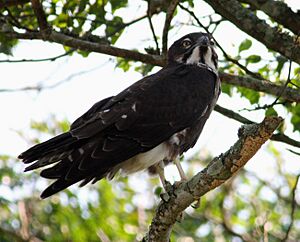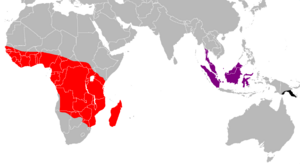Bat hawk facts for kids
The bat hawk (Macheiramphus alcinus) is a special bird of prey. It lives in parts of sub-Saharan Africa, south Asia, and New Guinea. This bird is famous for what it eats: mostly bats! It needs open spaces to hunt, but you can find it in many places, from thick rainforests to dry grasslands.
Quick facts for kids Bat hawk |
|
|---|---|
 |
|
| Bat hawk at Cape Vidal, northern Natal, South Africa | |
| Conservation status | |
| Scientific classification | |
| Genus: |
Macheiramphus
|
| Species: |
alcinus
|
| Subspecies | |
|
M. a. anderssoni M. a. alcinus M. a. papuanus |
|
 |
|
| Synonyms | |
|
Machaerhamphus alcinus Westerman, 1851 |
|
About the Bat Hawk
The bat hawk is a medium-sized bird of prey. It is usually about 45 cm long. It has long wings and looks like a falcon when it flies. Adult bat hawks are dark brown or black. They have a white patch on their throat and chest. They also have a white stripe above and below each eye. Young bat hawks are mottled brown. They have more white plumage (feathers) than adult birds.
How Bat Hawks Live
Hunting for Food
Bat hawks mainly eat bats. But they might also eat small birds. These can include swallows, swifts, and nightjars. Sometimes, they even eat insects. Bat hawks hunt by chasing their prey very fast in the air. About half of their hunts are successful. They catch bats using their small talons (claws). Then, they swallow the bats whole while still flying.
Bat hawks hunt at dusk, which is when the sun sets. This is when bats start to come out. You can often see them waiting near a cave or a place where bats live. They eat their prey while flying. This special way of eating means they have a very wide mouth. It's the widest mouth of any raptor for its body size! This wide mouth helps them eat very quickly. Bats only come out in swarms for about 30 minutes at dusk. So, a wide mouth helps the hawks catch and eat many bats in that short time.
Because they hunt at dusk, have a wide mouth, and can fly very well, bat hawks are great at catching bats. This special hunting style means they don't compete much with other birds of prey. Most other raptors hunt during the day.
Raising Young
When bat hawks want to find a mate, they do amazing aerial displays. They build their nests using sticks they gather while flying. The nest is about 90 cm wide and 30 cm deep. Only the female sits on the eggs to keep them warm. The male often brings her food.
About a month after the eggs are laid, they hatch. Both parents help feed the young birds. The young birds are ready to fly about 30 to 45 days after hatching. They leave the nest soon after. Bat hawks plan their breeding time to match when bats are having their babies. This way, the adult hawks can catch pregnant bats, which are slower. And the young hawks can hunt young bats that have just learned to fly. Bat hawks usually breed almost every year.
Staying Safe
The bat hawk lives in a very large area. Its population is also quite stable. Because of this, it is listed as a species of least concern. This means it's not currently in danger of disappearing. However, in some local areas, their numbers are dropping. For example, in South Africa, the bat hawk is listed as an endangered species.


